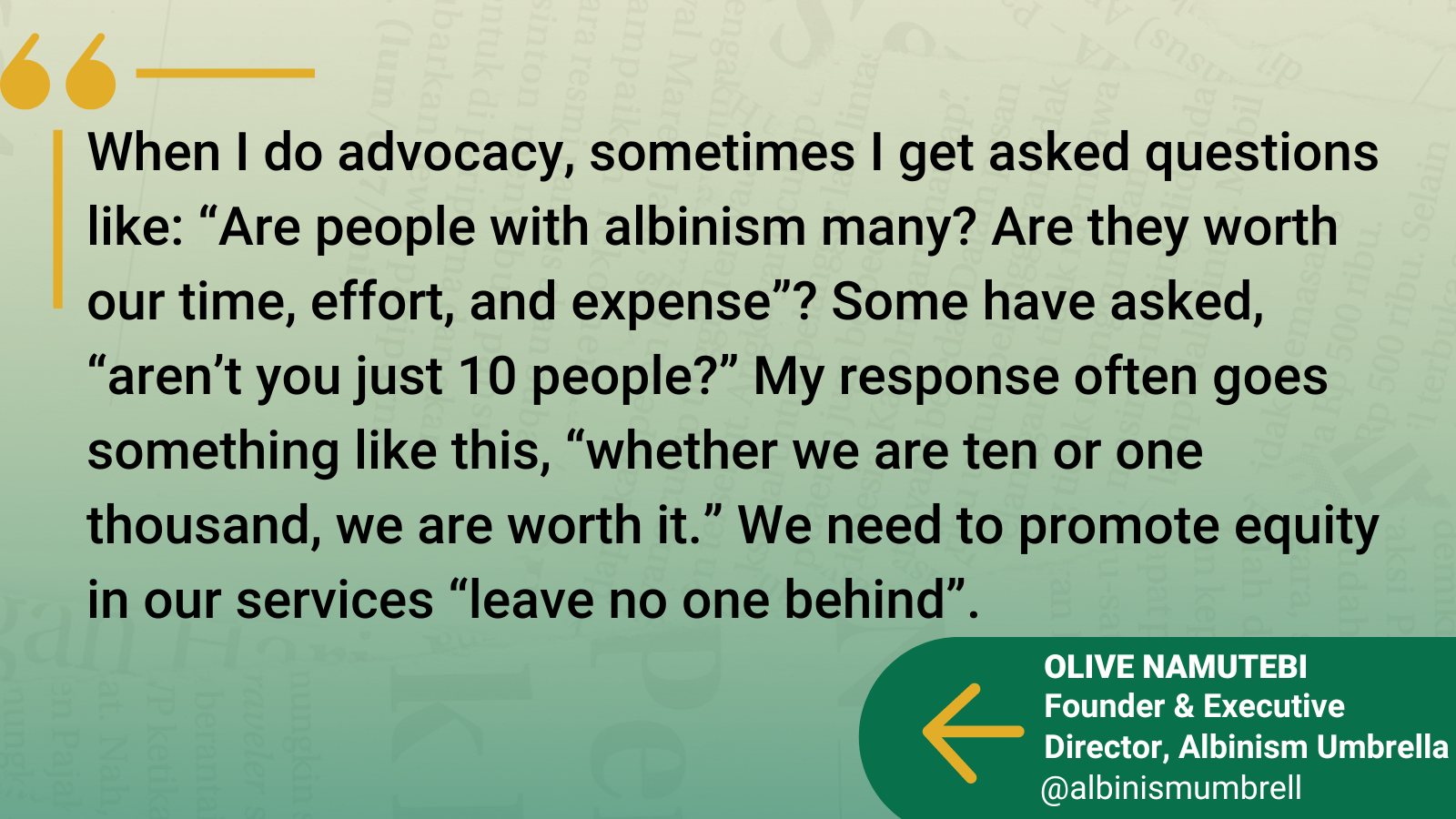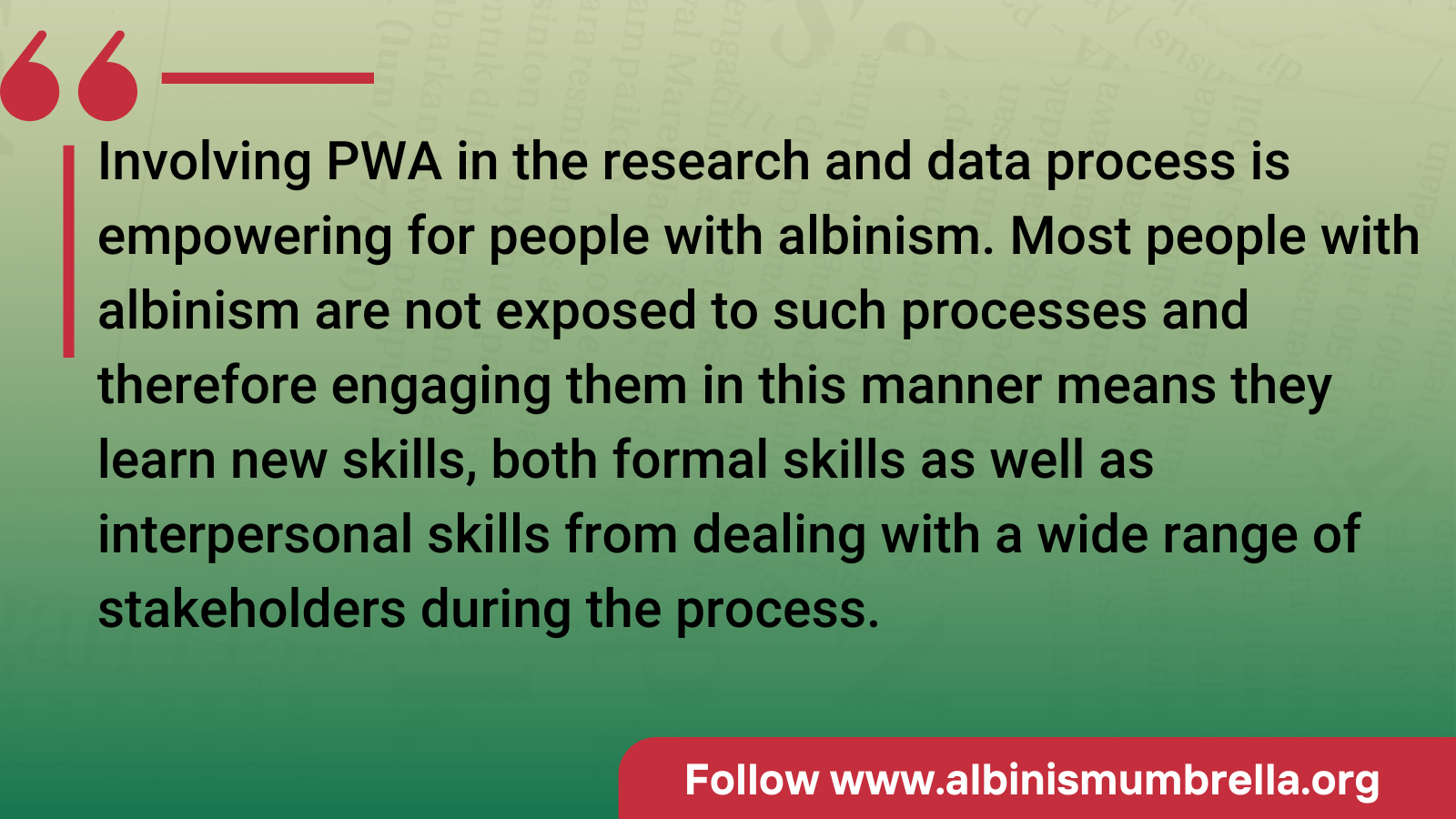It’s a great time for the albinism movement in Africa. The movement is not new per se, but it hasn’t fully matured either. So, it’s a good time to reflect on the many good things we have including the AU Plan of Action 2021-2031. However, it is also a good time to identify some areas where we should probably improve on in the next decade, over the span of the AU Plan of Action and beyond, such as research and evidence-based advocacy. For one of our first blog pieces, we chose to have an in-depth conversation with Olive Namutebi, a leader with albinism from Uganda, on the need for research and advocacy led by people with albinism.

Africa Albinism Network: Why do we need to do more evidence-based advocacy?
Olive Namutebi: We need to promote equity in our services “leave no one behind”. When 5 out of 10 people with albinism in one village are affected by skin cancer or threatened by physical attacks, then we can confidently say 50 percent of their population is impacted. People with albinism (PWA) should not be afraid to seek and use data for advocacy even when it seems small or insignificant in the grand scheme of things. Every life matters. People with albinism matter. The smaller the numbers, the more reason protection interventions are warranted. That said, any data collected should involve PWA themselves, in other words we need more PWA-driven research and data for advocacy.
AAN: How can we design research and involve PWA in evidence-building processes?
ON: It’s easier to involve PWA in social science research than in the natural sciences. However, to the extent that researchers can involve PWA – whether in data collection, or administration – they should. In many cases, PWA can bring their contacts, networks, and lived experiences to bear on research and data-gathering processes, making it rich and relevant
Involving PWA hinges on the notable disability activism slogan “nothing about us without us.” It ensures PWA are treated as subject matter experts of research and not merely objects to be studied, talked to, and “helped”. However, the involvement of PWA should be genuine. They should be involved in a meaningful way and not to check the inclusion box.
My organization, Albinism Umbrella has been involved in several albinism research and data-gathering processes in Uganda, for the goal of informing our advocacy. One of these was a special mapping of people with albinism across the country for a situation analysis. This process helped us get a sense of how many people with albinism are in the country and to understand their human rights situation including access to education, health, social services, level of poverty, protection and access to justice, among other issues. Another research we co-led was a baseline survey on knowledge about albinism. We targeted parents of people with albinism as well as people with albinism themselves. In this one, we were really taken aback by some of the results. A significant number of parents and caregivers of people with albinism where unaware of the harmful effects of skin cancer. A great number didn’t know the cause of albinism. We have since used this data to target our programming and advocacy including building content and aiming these at strategic groups such as family members of people with albinism and for a targeted time period and geographic location.
AAN: Why is PWA-driven research and data process important?
ON: The process inadvertently informs PWA about their condition and the social dynamics around albinism in their country. This knowledge in turn helps to build a common vision among the PWA involved, leading to solidarity which until recently was not easily achieved among PWA. Many of us know how we avoided each other in the past to reduce bringing attention to ourselves. No one wanted to exacerbate the discrimination.
The research process involving PWA also helps those of us who lead albinism organizations to identify new leaders in the movement. During the recruitment of PWA into the research process, we can assess education levels of various PWA, train them prior to their fieldwork and observe them throughout. In the end, we found potential and emerging leaders who would become resources for future work.
PWA interact with governments and other stakeholders during research processes. This opens up a mutual space for engagement, leading to direct creation of awareness with government and other stakeholders. The result is government action on the issue including in response to the preliminary data results. For example, during a research project that Albinism Umbrella undertook, district health officers, and education officers interfaced with PWA involved in the research process. The result was that people with albinism in the area where able to provide information to these officers who, as a result, improved access to quality health and education service to PWA in a way that PWA in the area had never received prior to the research.
Finally, involving PWA in the research process can help to expose PWA who are living with critical health conditions. This is important not only to record their cases, but to bring them life-saving or other urgent assistance. For example, we met a man during our research process who had an advanced infection that we presumed was cancerous. The situation was so extreme that family members moved out of the house to avoid the foul smell that oozed from the infected site. Once our team arrived at his home, as part of our research process, we quickly deciphered that he needed immediate medical attention. Unfortunately, once we arrived at the hospital with him, medical staff refused to attend to him for various reasons which revolved around stigma not unrelated to the infection and his albinism. I called the superintendent of the hospital – the most senior staff – and insisted that he be attended to. Of course, this quickly changed the attitude of the medical staff. While it was a difficult experience, it was an opportunity for advocacy to the hospital administration and medical staff.

AAN: How can we improve PWA-driven research and data for advocacy?
ON: First, funding the PWA movement allows more freedom and leadership to thrive. It’s worrisome how sometimes. we albinism leaders, will do what donors ask of us without much reflection on if it’s the appropriate approach for us. If we give leaders the space to go and find out what PWAs need and want, we will be surprised that there’s a huge gap between perception and reality at the community level.
Secondly, we need to cultivate more self-awareness or self-acceptance amongst ourselves as PWA. We need to accept that there are things we cannot change and change what we can (and as the prayer goes, we need to seek the wisdom to know the difference between both). Self-awareness and self-acceptance drive self-confidence and both are necessary for PWA to speak up for themselves respectfully and strategically especially vis à vis key stakeholders such as government, funders and so on.
Thirdly, we need home-grown solutions to our own issues. As Africans, we should seek less external validation. Our problems have local solutions. We can affirm ourselves with what is positive about ourselves. Once self-acceptance, self-awareness, and confidence are in place, it will become so much easier to find a way to live a better life where we are – especially with full use of our natural talents and abilities. Good solutions don’t always have to come from outside.
Fourthly, we need a rights-holder approach to advocacy. This is important because people with albinism can and should speak for themselves. The human rights-based approach allows and nurtures human agency meaning the leadership of the people being supported. This way we can be part of the process and enjoy the outcome of the process which leads to our own wellbeing and prosperity.
Fifthly, capacity development is important, but we need to be more strategic about which groups to prioritize within a country or community. Given the perennial issue of limited resources, let’s find those groups whose impact could ripple across society. As the saying goes: “train a mother and you train a whole nation.” Beyond this, we should train health workers, teachers, police etc. according to what our research and data indicates as the best strategy.
A united voice and common vision for the movement can move the needle. Even though our movement includes different organizations at different levels of growth, unity is possible. This could be done through the AU Plan of Action. However, because it is yet to be adopted or implemented in many countries, we need to keep promoting it. For now, I believe we can work on developing a common vision statement emanating from the Plan of Action, a vision that quickly, frequently and immediately reminds us of our shared dream. This in turn will minimize discord and maximize our collaboration and complementarity.
AAN: To conclude, how do you see the movement moving forward in Africa with context-appropriate research processes?
ON: Many positive things are happening for people with albinism in Africa. To measure impact, we need a baseline to work with. The baseline must center people with albinism so that the needs of people with albinism are not formulated in a board room. We need to grow our self-confidence so that we can be creative about finding African solutions to African problems. This way, we will affirm what is good about us, about our environment, and ensure the sustainability of all our advocacy initiatives that contribute to a better life for people with albinism across Africa.


